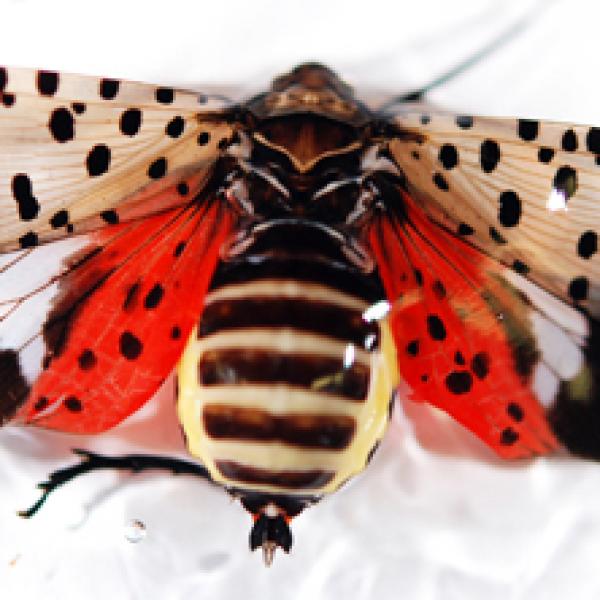
News Source
By Ed Ricciuti
The Scout Motto is the best advice for pest managers who want to establish a first line of defense against problematic invasive insects even before they become established, according to Dr. Surendra Dara, an IPM and crop advisor at the University of California. “Be Prepared,” is what he and his co-authors suggest in a paper published in the Journal of Integrated Pest Management on possible tactics to manage the invasive spotted lanternfly (Lycorma delicatula), which was detected last year in Pennsylvania. Pest managers who ignore reports of a new invasive species such as the spotted lanternfly because it is not yet established in their locale do so at their own peril, he said.
A planthopper in the family Fulgoridae, this undeniably colorful, inch-long insect can be enormously destructive to crops, timber, and ornamental plants. Among the 40 plant species counted as its hosts are grapes, peaches, apples, dogwood, maples, walnut, oak, and pines.The brilliant colors–– red, black, and white — of the spotted lanternfly reveal one of the reasons why it is difficult to control by using natural enemies. Its hues are warning colors that alert predators to the fact that the lanternfly is toxic due to poisons called cytotoxic alkaloids, which it metabolizes from some of its host plants. While the coloration of the forewings helps camouflage the lanternfly against a tree trunk, Dr. Dara says, the sudden flash of its vivid hindwings, when opened, startles predators and scares them away. Some birds have been seen vomiting after ingesting the insect. Although it is also toxic to humans, the lanternfly has been used in low quantities by practitioners of traditional Chinese medicine to treat consumption and swelling.
Native to northern China, the spotted lanternfly has spread to other parts of Asia, notably Korea and Japan. It has caused considerable damage in those countries, which is why state authorities in Berks County, Pennsylvania quarantined five townships and issued an alert document to help people identify the pest. The Pennsylvania Department of Agriculture removed more than 100,000 of the insects in 2015 alone, according to Dr. Dara’s paper. The adults are easy to catch because they seldom fly off when approached, preferring to hop away. Based in California, Dr. Dara’s focus on the spotted lanternfly is partly motivated by its potential threat to vineyards.
“I don’t want to scare people,” he said, “but it has the potential to spread, and we do not have a biological-control agent.” He stresses that even though the lanternfly remains confined to a small area of Pennsylvania, pest managers best be ready to identify it and be familiar with its biology and the control methods used elsewhere.
In Korea, the lanternfly has one generation a year. It lays eggs from August to November, usually in masses on smooth-barked trees, sometimes on inanimate objects such as fence posts and stones. Eggs are sometimes dispersed on materials transported by people. Spring brings the hatch, usually early in the day. The nymphs are black with white spots in the first three instars. The fourth and final instar is red and black. Adults grossly resemble some moths, but with a wider abdomen.
Dr. Dara’s paper provides a detailed description of both nymphs and adults. He also describes feeding methods, including the fact that older nymphs and adults often feed in groups, one of the clues to their identity. Adults and nymphs pierce the phloem and suck out soft tissue with their mouthparts. Heavy feeding causes wounds that ooze on tree trunks. The honeydew then accumulates around the base of the trees and serves as a medium for sooty mold, which can injure or kill the tree.
Most natural enemies of the spotted lanternfly are not effective enough for controlling them, according to Dr. Dara, nor are generalist predators. Parasitic controls are few, although a few that are native to Asia may work there. A parasitic wasp called Anastatus orientalis may have potential because it is reported to parasitize up to 69 percent of spotted lanternfly eggs in China.
“Where they are found, preserving natural enemies could significantly lessen the risk of this insect reaching pest status,” Dr. Dara said.
Among chemical controls, some broad-spectrum pyrethroids, several botanical insecticides, and a few others seem to reduce adult populations. But pesticides seem to be ineffective for long-term control, and lanternflies can quickly repopulate vineyards after spraying.
Sticky bands around the trunks of host trees, preferably colored brown, can be used to trap large numbers of young nymphs as they ascend. Dr. Dara suggests some attractants may be effective when trapping lanternflies, and a few agents may repel them. However, they all need more testing. Adults and nymphs in the second-to-fourth instar stage appear to be attracted to spearmint oil, which could be used for control purposes. For now, the spotted lanternfly remains confined to a small area of Pennsylvania, but according to Dr. Dara, all appropriate interests should stand by, keep watch, and — especially — be ready.